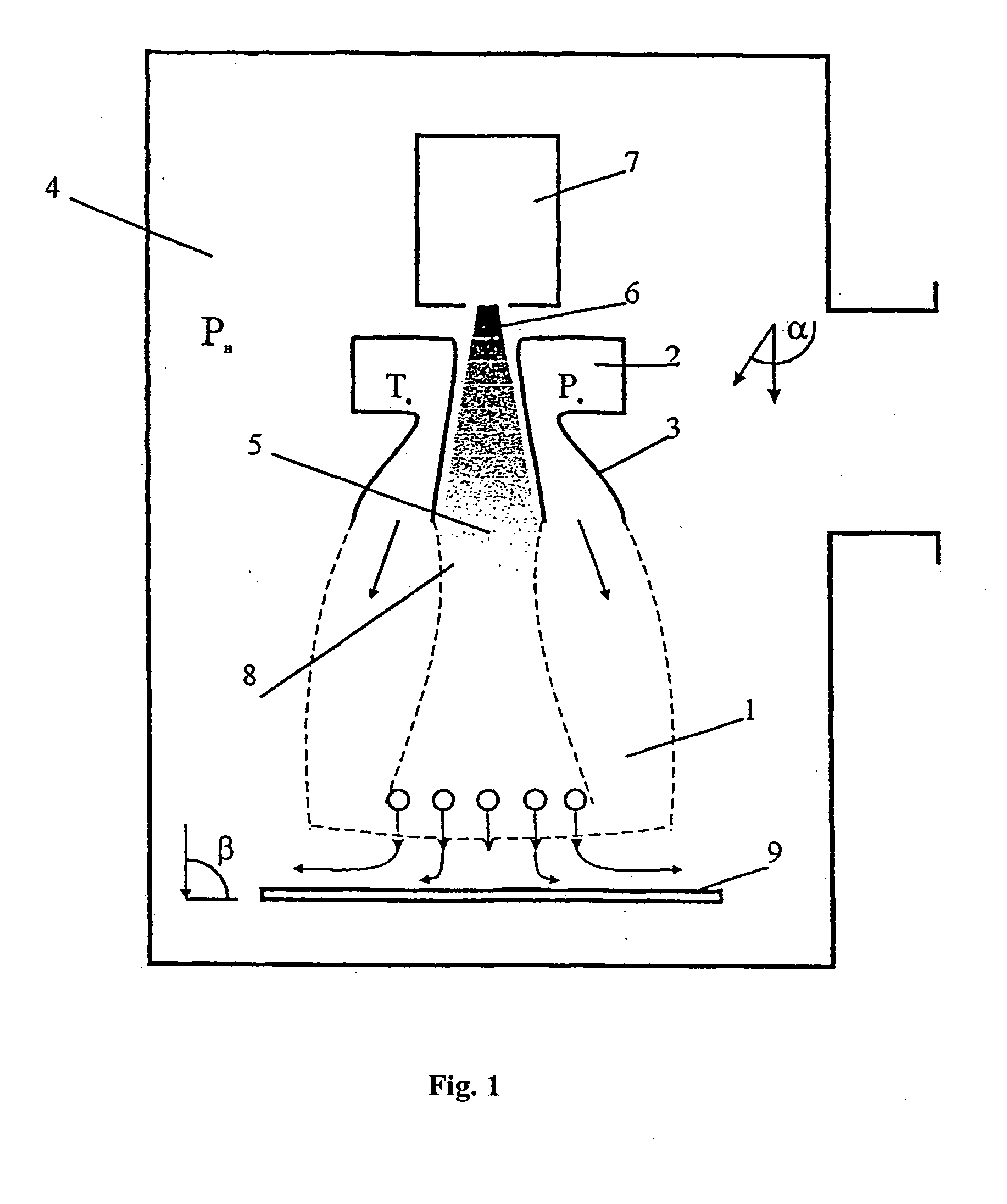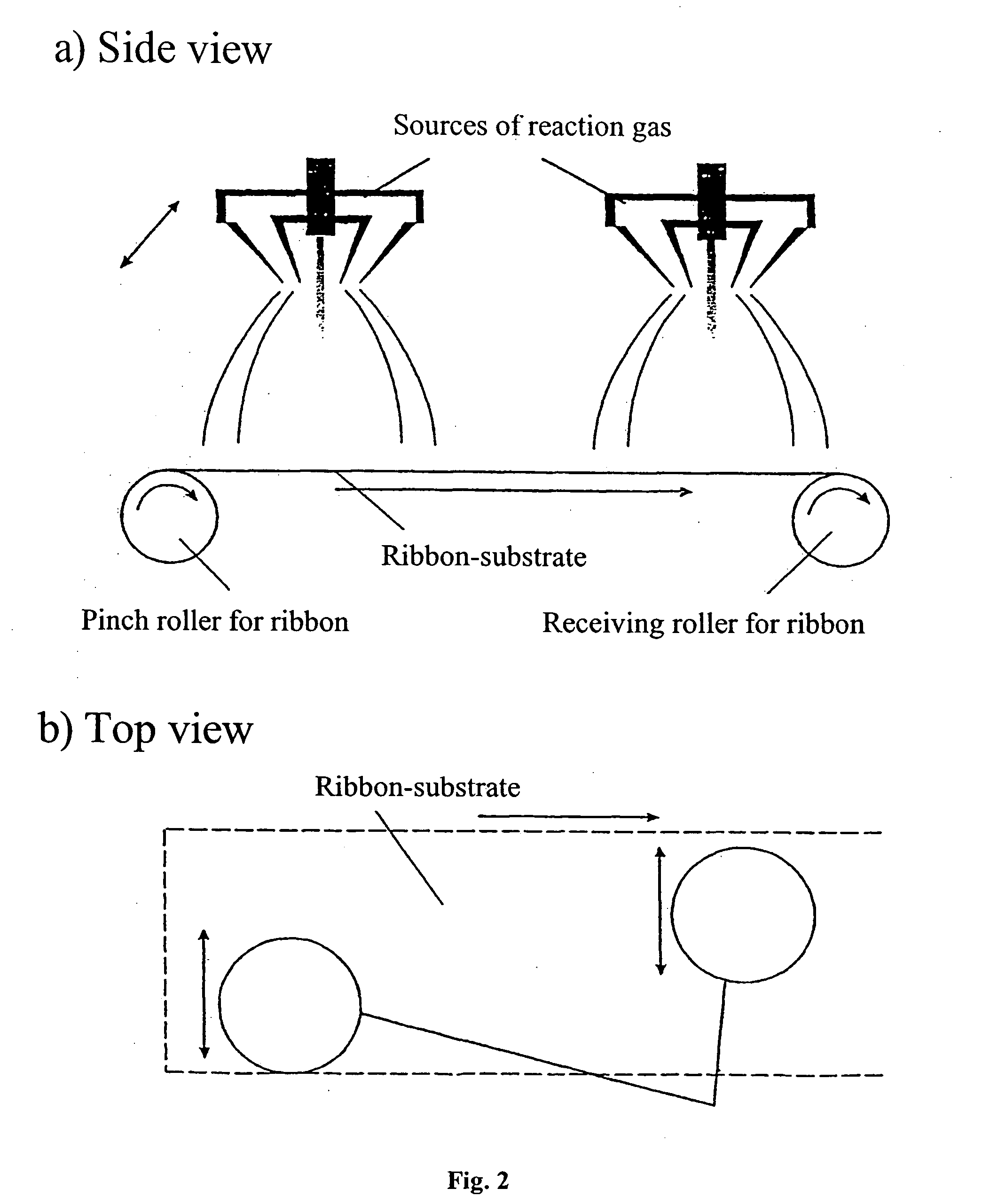Method for carrying out homogeneous and heterogeneous chemical reactions using plasma
a technology of homogeneous and heterogeneous chemical reactions and plasma, applied in the chemical field, can solve the problems of inability to obtain extra pure substances, frequent replacement of electrodes, and inability to quickly become useless
- Summary
- Abstract
- Description
- Claims
- Application Information
AI Technical Summary
Benefits of technology
Problems solved by technology
Method used
Image
Examples
example 1
[0043] For applying a silicon film to the surface of a substrate made of stainless steel the reaction gas is used, which contains monosilane SiH4 and argon Ar as the carrier. The plant for applying the film on the substrate is made in accordance with the diagram shown in FIG. 1. It comprises the reaction vacuum chamber (4), the annular source (2) of the reaction gas, which is combined with the electron gun (7). The plant comprising the annular reaction gas source combined with the electron gun is shown in FIG. 4.
[0044] By continuous pumping out the gas from the volume of the vacuum reaction chamber the pressure of 10−2 torr is maintained in it. Helium is fed with the flow rate of 50 cm3 / min from an external supply system to the volume of the plasma electron gun with the hollow cathode. The electric potential of 0.2-0.3 keV is applied between the cathode (1) and the anode (2) from an external source of discharge. In the result, a glow discharge appears in the hollow cathode (21). Th...
example 2
[0045] The hydrogenation of silicon tetrachloride SiCl4 to trichlorosilane is carried out. For this the plant is used, which is shown in FIG. 4 and described in detail in Example 1, with a quartz tube of cylindrical section, which is installed instead of the substrate (31). The axis of cylinder coincides with the axis of the reaction gas flow. A mixture of silicon tetrachloride and hydrogen in the molar relation 1:4 (silicon tetrachloride to hydrogen) is introduced in the annular source through the tube (13) to the prechamber (14) as the reaction gas. The reaction gas is supplied from a special evaporator. The electron beam with the accelerating potential of 2 keV is introduced into the reaction gas flow in the zone of negative pressure. At the exit from the vacuum reaction chamber a sampling device is arranged, in which a sample of the reaction gas, as treated in the plasma, is collected. As the sampling device a cryogenic trap is used, which is cooled down to the liquid nitrogen t...
example 3
[0047] Pure polycrystalline silicon is to be obtained. The process is carried out at the same conditions, as in Example 1, in the plant, which is shown in FIG. 4. The substrate of cylindrical form, which is made of metal foil, is placed in a heated cylindrical quartz tube, the axis of which coincides with the axis of the reaction gas flow containing SiH4 and He. The substrate has a cylindrical form in order as many as possible silicon particles activated in the plasma may be deposited on it—ultimately, all such particles. By the weight of the silicon, which is deposited on the substrate surface, the specific power inputs and the coefficient of transformation of gaseous monosilane into polycrystalline silicon on the substrate surface are determined. At the electron beam accelerating potential of 2 keV, the beam current of 0.3 A, the reaction gas flow rate of 12 L / min and the substrate temperature of 750° C. the specific power inputs are 200 kJ per 1 g of silicon, and the use factor o...
PUM
| Property | Measurement | Unit |
|---|---|---|
| Pressure | aaaaa | aaaaa |
| Pressure | aaaaa | aaaaa |
| Density | aaaaa | aaaaa |
Abstract
Description
Claims
Application Information
 Login to View More
Login to View More - R&D
- Intellectual Property
- Life Sciences
- Materials
- Tech Scout
- Unparalleled Data Quality
- Higher Quality Content
- 60% Fewer Hallucinations
Browse by: Latest US Patents, China's latest patents, Technical Efficacy Thesaurus, Application Domain, Technology Topic, Popular Technical Reports.
© 2025 PatSnap. All rights reserved.Legal|Privacy policy|Modern Slavery Act Transparency Statement|Sitemap|About US| Contact US: help@patsnap.com



